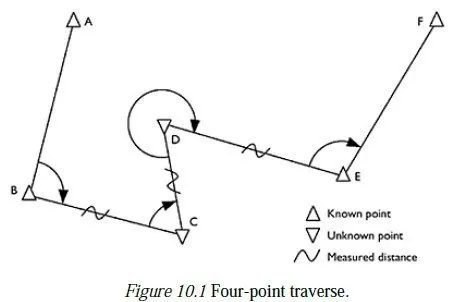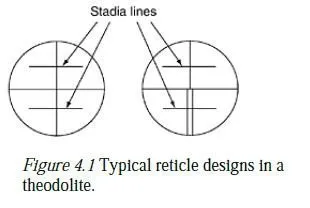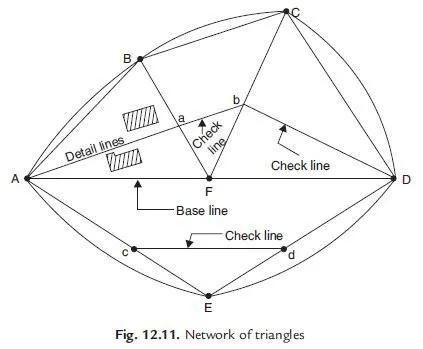To get accurate results in surveying one should follow the following fundamental principles:
(i) Work from whole to part
(ii) Take extra care in fixing new control points.
11.3.1 Work from Whole to Part
In surveying large areas, a system of control points are identified and they are located with high precision.
Then secondary control points are located using lesser precise methods. The details of the localised areas are measured and plotted with respect to the secondary control points. This is called working from whole to part. This principle in surveying helps in localising the errors. If the surveying is carried out by adding localised areas errors accumulated and may become unacceptable when large area is covered.
11.3.2 Extra Care in Fixing New Control Points
Figure 11.3 shows the various methods of fixing point C with respect to already fixed points A and B by measuring sides, angles or setting perpendiculars. For fixing new control points (stations) with respect to already fixed points at least two independent process should be followed. If A and B are already located control points and with respect to them new control point C is to be located, apart from the minimum measurements required as shown in Fig. 11.3, one more measurement should be taken. Measuring the lengths of check lines and tie lines will also serve this purpose (Ref. Fig. 11.4).






i want to be getting information on this site
I need information on this site, am a survey student
I AM A STUDENT OF THE UNIVERSITY OF LIBERIA READING CIVIL ENG. I AM A REGULAR VISITOR TO THIS SITE, AND MIGHT WANT TO KNOW THE BASIC PRINCIPLE OF SURVEYING WITH SOME HISTORICAL BACKGROUND IN SURVEYING.
Thank you. Na God
iam a survey student at fiji national university and need some fundamental information on this topic
with the current increase in surveying insrumentation and space technology the need for the basic principle of WORKING FROM WHOLE TO PART no longer holds.DISCUSS.
applications of surveying to today's urban planning